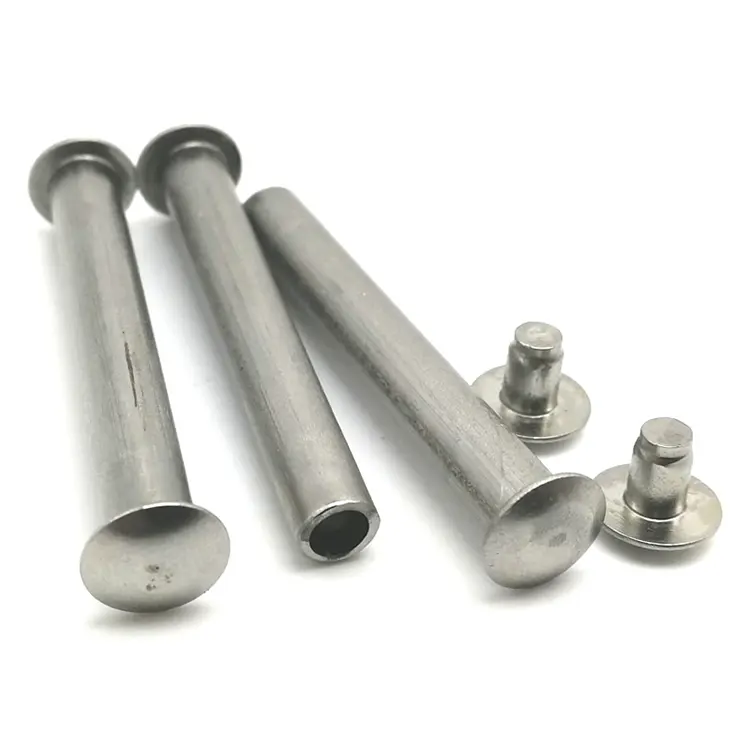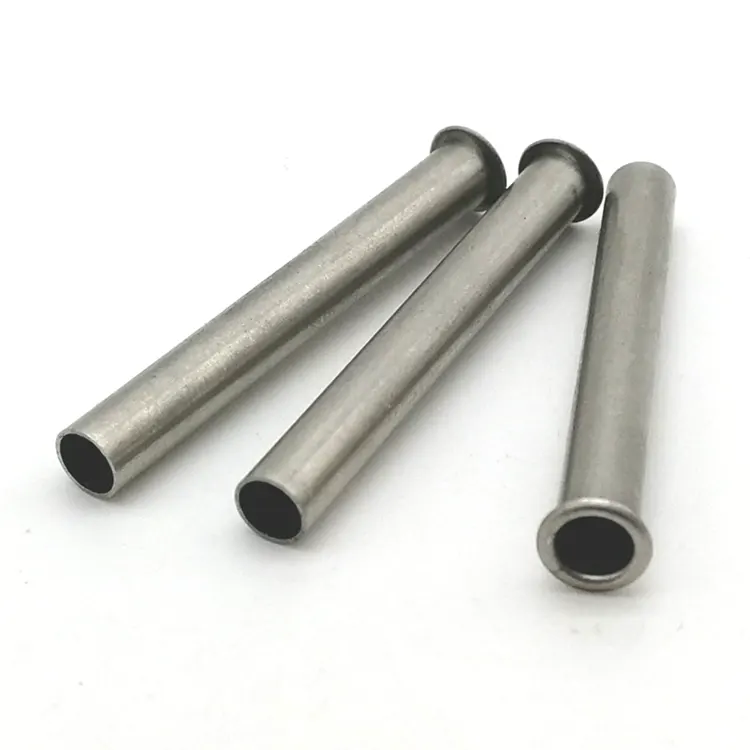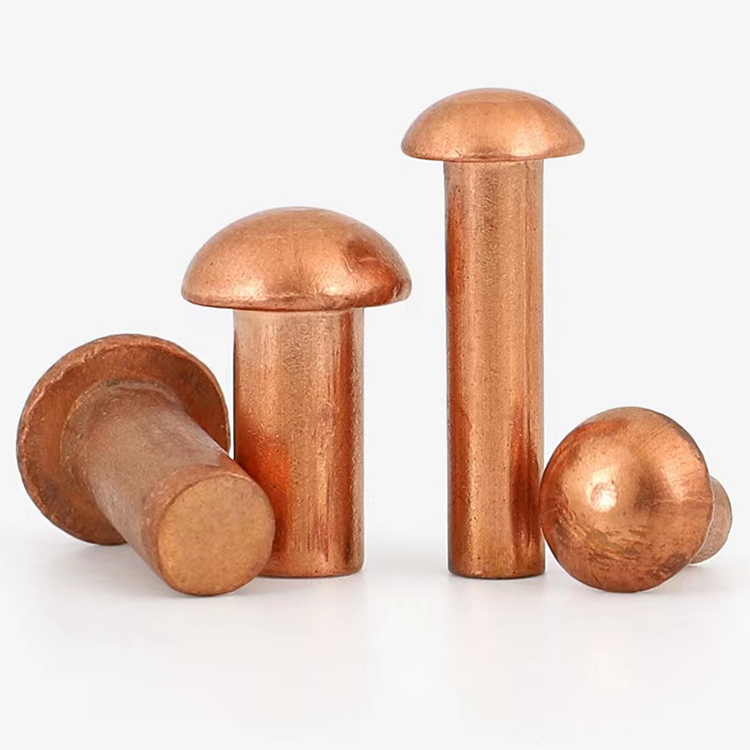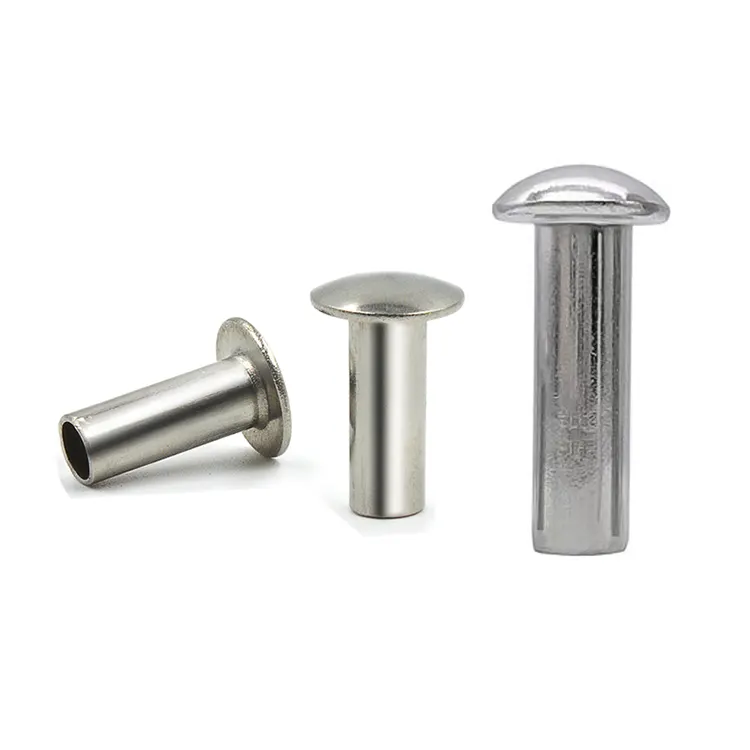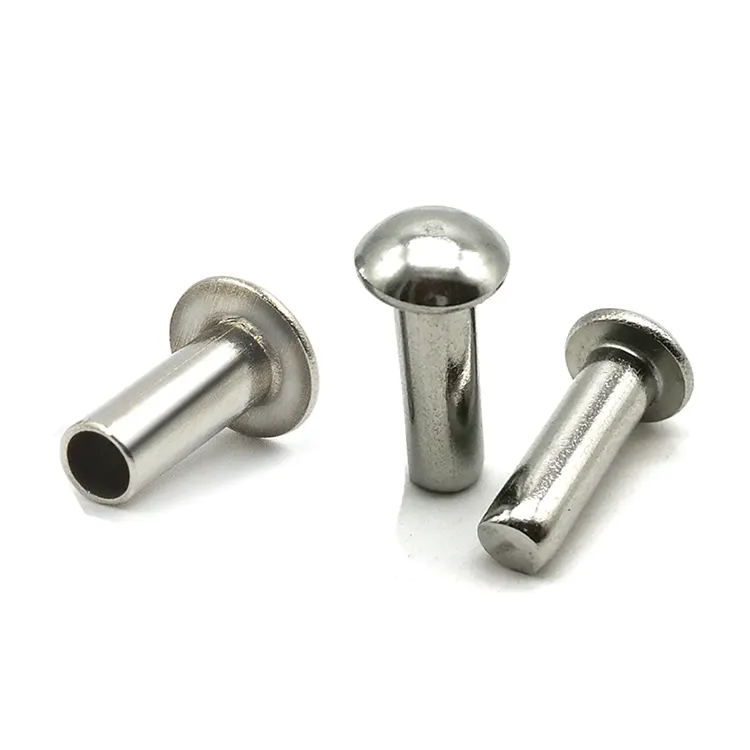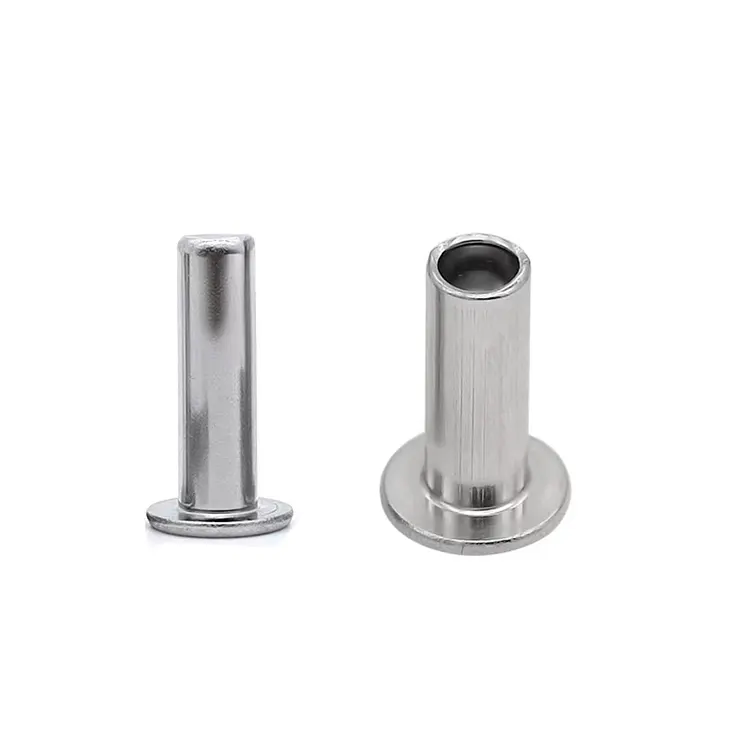Rivetti
As one of professional manufacturer in China, Notin would like to provide you Rivets. And we will offer you the best after-sale service and timely delivery.
What is a rivet?
A rivet is a permanent mechanical fastener used to join two or more materials. Rivets work by inserting a metal pin into an aligned hole and deforming the end, creating a strong, secure, and durable connection. Unlike temporary fasteners like screws, rivets do not rely on threads, but instead form a permanent connection, making them ideal for applications requiring high strength, durability, and vibration resistance.
Classification of Rivets
Rivets are typically categorized by head shape, degree of hollowness, or material.
Based on head shape, rivets can be classified as flat head rivets, round head rivets, countersunk head rivets, mushroom head rivets, universal head rivets, truss head rivets, etc.

Based on degree of hollowness, rivets can be classified as solid rivets, semi-tubular rivets, or full tubular rivets.
Based on material, rivets can be classified as brass rivets, stainless steel rivets, steel rivets, aluminum rivets, copper rivets, etc.
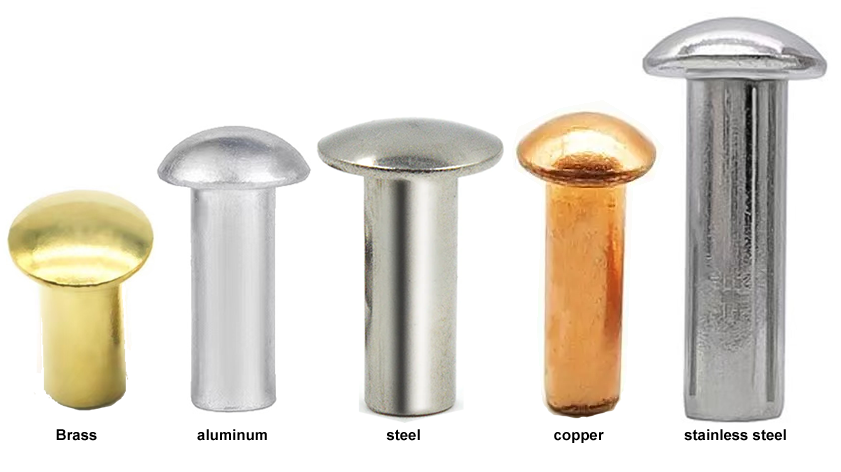
What surface finishes are available for rivets?
Rivet surfaces are typically treated with rust-proofing treatments, primarily electroplating, including zinc plating, nickel plating, chrome plating, tin plating, gold plating, and silver plating. Electroplating is a common rust-proofing method for rivets. It applies a layer of plating to the rivet surface through physical or chemical methods. The plating effectively prevents corrosion and rust, while also providing a certain aesthetic effect.
Another special surface treatment method is head coating. Head coating is performed after the rivet is electroplated. This allows for a variety of colors on the rivet head, achieving an aesthetically pleasing finish.
Aluminum rivets cannot be electroplated, but they can be anodized. Anodizing also allows for a variety of color options, but the unit price is higher than electroplating.
Rust-proofing the rivet surface is crucial, effectively extending the rivet's service life and ensuring a secure connection. Different rust-proofing methods are suitable for different environments and applications, so the choice should be tailored to the specific situation.
- View as
Rivetti in acciaio inossidabile
Nuote Metals è un produttore di rivetti professionale. Produciamo rivetti con alta precisione, una superficie di taglio piatta e una superficie liscia ed esteticamente gradevole. I rivetti in acciaio inossidabile sono un comune elemento di fissaggio in metallo, utilizzato principalmente in applicazioni di connessione specializzate o ad alta resistenza. Sono costituiti da un gambo e un cappuccio. La forza esterna deforma il gambo, collegando saldamente due o più pezzi. Questi rivetti offrono un'elevata resistenza alla trazione e al taglio, rendendoli adatti all'uso in una varietà di applicazioni industriali.
Per saperne di piùInvia richiestaRivetti a testa cilindrica in acciaio inossidabile
Nuote Metals è un produttore di rivetti affidabile in Cina, che produce rivetti in una varietà di materiali, tra cui ottone, ferro, alluminio, acciaio inossidabile e rame. I rivetti a testa bombata in acciaio inossidabile sono la scelta ideale per numerosi settori grazie alle loro eccellenti proprietà di fissaggio, resistenza alla corrosione superiore, specifiche diverse e un'ampia gamma di applicazioni. Che si tratti di produzione industriale, decorazione architettonica, produzione automobilistica o fai da te domestico, i rivetti a testa cilindrica in acciaio inossidabile forniscono una soluzione di connessione affidabile, aggiungendo un livello di sicurezza a qualsiasi progetto.
Per saperne di piùInvia richiestaRivetti a testa di fungo in acciaio inossidabile
Nuote Metals è specializzata nella produzione di rivetti a fungo in acciaio inox. I nostri rivetti in acciaio inossidabile vantano una finitura brillante. Dallo stoccaggio delle materie prime alla produzione e spedizione, controlliamo rigorosamente ogni dettaglio per garantire che ogni rivetto venga consegnato ai nostri clienti con aspetto e dimensioni impeccabili. Realizzati in acciaio inossidabile, questi rivetti a forma di fungo sono resistenti alla corrosione e possiedono elevate proprietà meccaniche. Sono ampiamente utilizzati in applicazioni di rivettatura come valigie, abbigliamento e attrezzature industriali.
Per saperne di piùInvia richiestaRivetti a testa piatta in acciaio inossidabile
Nuote Metals è specializzata nella produzione di rivetti a testa piatta in acciaio inox. Utilizziamo materiali SUS304 o SUS316L, ottenendo una superficie liscia e priva di graffi. Le dimensioni vengono rispettate rigorosamente sui disegni del cliente e il nostro reparto di controllo qualità controlla rigorosamente sia l'aspetto che le dimensioni per garantire che ciascun rivetto soddisfi le specifiche del cliente. I rivetti a testa piatta in acciaio inossidabile sono realizzati principalmente in acciaio inossidabile, una lega nota per la sua resistenza alla corrosione, alle alte temperature e all'elevata resistenza. Ciò garantisce che questi rivetti in acciaio inossidabile a testa piatta rimangano stabili anche in ambienti umidi, acidi o alcalini, resistendo alla ruggine o alla deformazione.
Per saperne di piùInvia richiestaRivetti a testa svasata in acciaio inossidabile
i rivetti a testa svasata in acciaio inossidabile sono realizzati in acciaio inossidabile per garantire resistenza alla corrosione e durata. I materiali comuni in acciaio inossidabile includono 304 e 316 e il materiale specifico da utilizzare dipende dall'ambiente e dai requisiti dell'applicazione specifica. Nuote Metals è specializzata nella produzione di rivetti in acciaio inossidabile, comprese varie forme di testa, come rivetti in acciaio inossidabile a testa piatta, rivetti in acciaio inossidabile con testa a cupola, rivetti in acciaio inossidabile con testa a fungo, rivetti in acciaio inossidabile con testa cilindrica e altro ancora. Accogliamo con favore le vostre richieste.
Per saperne di piùInvia richiestaRivetti sulle spalle
Nuote Metals produce e fornisce rivetti a spalla, chiamati per la loro somiglianza con i gradini. Con sede a Dongguan, in Cina, produciamo questi rivetti in una varietà di materiali, tra cui acciaio inossidabile, rame, ferro e alluminio. Tutti i rivetti a spalla sono realizzati secondo i vostri disegni o campioni per soddisfare le vostre specifiche esigenze di rivettatura. I nostri rivetti sono rifiniti con precisione e possono adattarsi a una varietà di trattamenti superficiali, tra cui galvanica, elettroforesi e anodizzazione.
Per saperne di piùInvia richiestaWhat are the advantages of rivets over other fasteners?
1. Ease of Installation
Rivets are fast to install, and even fully automated for high-volume applications, resulting in a simple and efficient operation process.
2. Connection Reliability
The riveting process is standardized, with strict quality control, resulting in highly stable connections. Visual inspection allows for quick verification of connection quality.
3. Vibration and Impact Resistance
Rivets connect through deformation or interference fit, providing strong clamping force and excellent vibration resistance, capable of withstanding vibration and shock.
4. Low Cost
Rivets are easy to install and can be fully automated, saving significant labor costs.
What are the advantages and disadvantages of rivets made of different materials?
Aluminum Rivets
Advantages: Lightweight, reduces overall product weight, low cost, suitable for general civilian applications.
Disadvantages: Low tensile and shear strength, unsuitable for high-strength workpieces, prone to electrochemical corrosion when in contact with metals such as stainless steel.
Stainless Steel Rivets
Advantages: Strong corrosion resistance, high hardness, suitable for high-strength workpieces (such as marine equipment)
Disadvantages: Higher cost, typically more expensive than aluminum rivets of the same specification.
Brass and Copper Rivets
Advantages: Excellent conductivity (such as connecting electronic components), good corrosion resistance.
Disadvantages: Higher cost, more difficult to process.
Steel Rivets
Advantages: High hardness, high connection reliability, and wide applicability.
Disadvantages: Compared to other materials, iron rivets are more prone to rusting.
What are the main applications of rivets?
Rivets have a wide range of uses, from small items like a pair of scissors to large items like airplanes and ships, as well as in high-precision medical applications.
Industrial Manufacturing
Rivets are used in a wide variety of industrial fields, wherever there is a need to connect two or more materials.
Electronics
Rivets secure heat sinks and chips, providing both vibration damping and noise reduction, and are widely used in the cooling systems of electronic products such as computers and mobile phones.
Automotive
Rivets are widely used to connect components of automobile bodies and chassis, such as doors and hoods. Their lightweight and corrosion-resistant properties make them an indispensable joining method in automotive manufacturing.
Aerospace
In aircraft manufacturing, rivets are used to connect different fuselage components, such as wings and tailplanes. Millions of rivets create high-strength, corrosion-resistant joints. Aluminum and titanium alloy rivets are often used to connect components of corresponding materials, ensuring stability in extreme environments.
Rivets are used everywhere. The above examples only represent a small number of their applications. We see rivets everywhere in our daily lives, such as on scissors, folding beds, and strollers etc. Rivets can be customized to different sizes and materials depending on the application.
Nuote Metals has specialized in the rivet industry for over a decade. Our factory is located in Dongguan, a city known as the "World Factory," a city with a developed industry and convenient transportation. This allows us to respond quickly when acquiring raw materials and supporting surface treatments, meeting our customers' needs for quick access to samples and bulk orders. We produce 10 million rivets daily and have molds of various specifications, allowing us to produce rivets as small as 0.8mm and as large as 10mm. We welcome your inquiries and visits.

